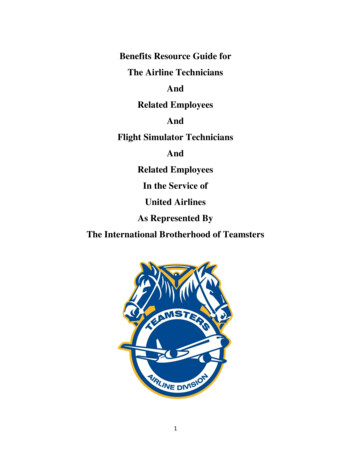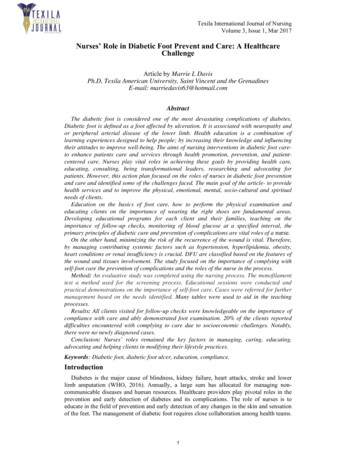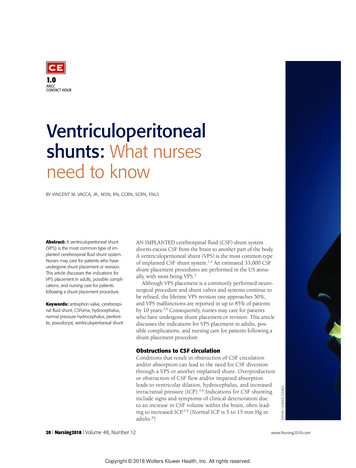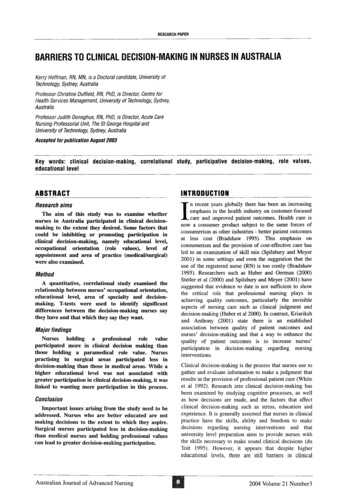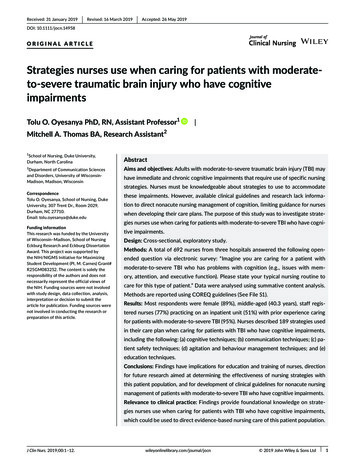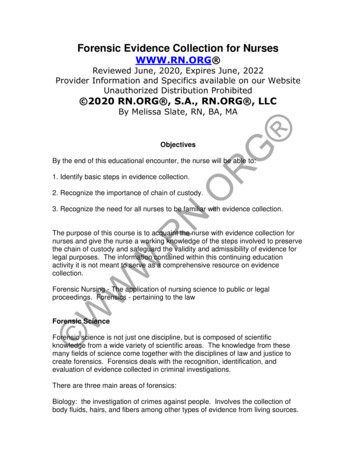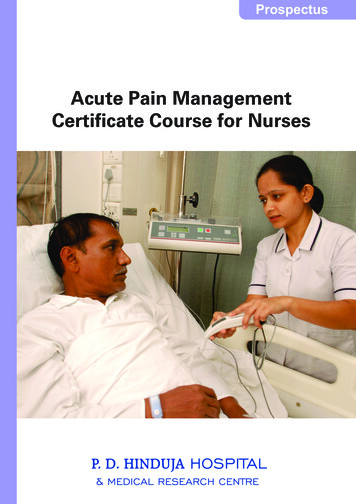
Transcription
ASCRS ASOA Symposium & CongressTechnicians & Nurses ProgramMay 6-10, 2016 – New Orleans
UnderstandingAnterior Segment OCTClinical Applications ofAnterior Segment OCT Sarah Moyer, CRA, OCT-C, FOPSManager of Ophthalmic ImagingKenneth L. Cohen, MDSterling A. Barrett Distinguished ProfessorKittner Eye CenterDepartment of OphthalmologyUniversity of North Carolina at Chapel HillSchool of MedicineAnatomyVendorsClinical use of AS-OCTTechnical aspectsMeasurementsArtifactsRecent CasesNo financial interestWhat Does Anterior SegmentOCT Do?Anterior Segment AnatomyIrisLimbusCorneaAnterior Chamber2-dimensional cross section image of theanterior segmentPupilAngleLensCiliary BodyCorneal AnatomyCorneaAir / tear interfaceTear FilmEpitheliumStromaEndotheliumDSEK with foldHydropsBullous KeratopathyKeratoconusPhoto Credit: Media Resources Centre University Hospitals of Wales Cardiff UKThanks Chris Tetley!1
Iris and Anterior Chamber AngleLensNatural LensIris CystAnterior Chamber IOLClosed AngleElevated IOPIris CystCapsular BlockOpen AngleSlipped LensNarrow Occludable AngleIris NeoplasmMartha Leen, M.D. & Paul Kremer M.D. Achieve Eye and Laser Specialists, Silverdale, WAConjunctiva and ScleraPterygiumK-Pro Courtesy Mark Thomas and Ellen 3000OptosOCT/SLOScleral BuckleOptovueAvanti /RT-Vue /iVueTopconSL Scan-1 / OCT-2000ZeissVisante / CirrusConjunctival LesionFiltering BlebCourtesy of Achieve Eye and Laser SpecialistsOPMI LUMERA 700 and RESCAN 700Why Do I Image theAnterior Segment?2
1 Week After Phaco and1-Piece Posterior Chamber IOLDislocated IOLIOL in the Capsular BagAbbott Tecnis 1-Piece IOLCauses of the Dislocted IOL IOL not in capsular bag but in ciliary sulcusRuptured zonulesHole in posterior capsuleBroken hapticCrimped hapticRelationship BetweenIOL and Capsular Bag?Relationship BetweenIOL and Capsular Bag? How can I obtain a 2-dimensionsal crosssectional image of the anterior segment ofthe eye?Anterior segment OCTImmersion B-scan ultrasoundAnterior Segment OCTTechnical SpecificationsHorizontal meridianIOL optic and posterior capsule3
OCT Specification Trans 00Spectral32,000 4 40,0003.9 μm14 μm1.9mm16mmOptosOptosOCT/SLOSpectral27,000 6.0μm20 μm2.02.3mm6mmOptovueiVueSpectral26,0005.0 μm15 μm22.3mm12mmExtOptovueRT-VueSpectral26,0005.0 μm15 μm22.3mm12mmExtZeissZeissCirrusSpectral27,0005 μm15 μm2mm4mmIntVisanteTime2,00018 μm60 μm6mm16mmIntBioptigenTime and Spectral Domain OCTExtNot currently FDA approved with AS-OCT from the following manufactures:Nidek, Optopol, Tomey, and Topcon (as of March 2012)Anterior Segment SpecificationsSpecificationsVisanteSpectralSLD Wavelength1310840-870Optical Power 6500 µW750µWAnterior Segment SpecificationsSpecificationsVisanteSpectralSLD Wavelength1310840-870Higher Wavelength allows for deeperscan depth and longer scan lengthScan Depth3mm,6mm1.9-2.3mmMore scan depth is able to imagecornea to lensScan Length10mm,16mm1-2,1-6*Longer scan length can image limbusto limbus. *Heidelberg is exception6x163x10The longer wavelength of light and stronger optical power allow TDtechnology to penetrate deeper into the angle.The shorter wavelength of light and lower optical power make itpossible for the SD technology to also image the retinaShorter Scan LengthBetter Resolution2x62x1Graphic modified from Zeiss21 Months Postop DSEKHeidelbergAvoid the corneal reflexThe following two slides show one individualwearing a 13.50 soft contact lensOpacities in interfacesm4
Fuchs’ DystrophyHeidelbergLonger scanlength givesbetter overview15 degreesGuttae more visible with high magnification20 degreessmImportance of Scan Length DSEKSlipped DSEK ComparisonLonger vs Shorter Scan Length16mm10mm6mm6mmLimbus to limbus imaging is necessary toensure proper attachment of the donor tissue Scleral Contact Lens FittingNeeded to view the entire lens in one image GlaucomaAble to measure both angles from one image.Courtesy Team Doheny EyeScleral Contact LensGlaucomaText5
New Corneal TransplantationTechniquesWhy Does this Patient HaveCorneal Edema?Hazy corneaFuchs’ Corneal Dystrophy Fuchs’ dystrophyInherited disease of corneal endotheliumEndothelium dysfunctional edemaPumps H20 out of corneaThickness 550 µ transparentPachymetry Specular microscopyGuttaePenetrating Keratoplasty1 year for visual rehabilitationIrregular healing of full thickness incisionVisually disabling astigmatismStromal and epithelial edemaPenetrating KeratoplastyEpithelial defectFull thickness corneal transplant360 corneal incision and suturesNew TreatmentDSEK: Descemet’s StrippingEndothelial Keratoplasty Diseased endothelium and Descemt’smembrane removed (30 μ) Donor endothelium and stroma inserted( 150 μ) Small incision (5 mm) Rapid healing and visual rehabilitation in30 to 60 days6
DSEK VideoOCT to Monitor Health of DSEK1D1038 μ1W618 μ1M687 μDSEK 4 Weeks Post-opUltrasound Pachymetry Incorrect Normal thickness 550 μ 30 μ endothelium and Descemet’smembrane removed 180 μ donor cornea implanted Pachymetry after DSEK should be at least700 μUltrasound pachymetry 549 μDSEK 4 Weeks PostopVisante Flap ToolCorneal thickness 769 μ7
Detached DSEK 1 Day PostopAnterior Segment OCT DESK attachment would indicate primarydonor failureRequire graft replacement DSEK detachmentReattach graft with airDSEK ReattachmentAir Injection1 day postop7 weeks postopMalpositioned DSEK1 week postop4.5 months postopWhat Else Can be MeasuredWith the OCT?Malpositioned DSEK180 meridian90 meridianSlipped inferiorly8
Available Measurements of theAnterior Segment Corneal thicknessAnterior chamber depthAnterior chamber angleIncisionTumor size and depthCorneal ThicknessAutomated Global PachymetryGlobal PachymetryPachmate Pachymetry16 line scans2048 data points in one map1 data point770 μAnterior Chamber DepthPre-OpPost-Op3.61 mm5.16 mmCorneal thickness 769 μMeasuring AnglesMeasuring Angles AOD: angle-opening distance TIA: trabecular-iris angle TISA: trabecular-iris space area9
Clear Corneal IncisionClear Corneal IncisionDescemet’s detachmentEndothelial gapeIris TumorsEndothelial misalignmentEpithelial misalignmentEpithelial gapeLack of coaptationArtifact on the ScanMust understand what is real andwhat is an artifactUnable to use measurement features in Raw ModeArtifacts Corneal ReflexCorneal ReflexInverted Image (in Spectral Domain)ShadowingImage AveragingAlgorithm FailurePachymetry: Corneal surface linesPachymetry: Lids10
Inverted ImageSpectral Domain21 Months Postop DSEKHeidelbergAvoid the corneal reflexOpacities in interfacesmShadowingShadowingImage AveragingAveragingEnhanced High Res Cornea ModeTop: Non-averaged ScansBottom: Averaged Scans11
Measuring with AveragingDewarpingEnhanced High Res Cornea ModeEnhanced ModeAlgorithm Failure Due to LidsAlgorithm Failure Due to LidssuperiorinferiorAlgorithm FailureDue to Corneal Surface LinesOCT is a Tool Useful for FollowingClinical Problems12
Visualize Depth of Corneal ScarVisualize Depth of Corneal ScarFlattening of corneal surface over scarDSEK with a scarExcellent detail of corneaCorneal and ConjunctivalIntraepithelial NeoplasiaOcular Surface Tumors Does the tumor extend into the cornea,sclera, and anterior chamber angle? Plan operative procedureCorneal and ConjunctivalIntaepithelial NeoplasiaInfectious Keratitis Hazy corneaDifficult to see extent of corneal involvementMonitor response to medical therapyFollow disease process13
Fungal Corneal UlcerAnterior Chamber Depth Important for IOL calculation Theoretical prediction formula: Haigis Required to predict the post-opposition of the IOL Correct IOL power can be inserted 0.05 mm ACD error 0.03 diopterIOL power errorPre-op Phaco IOL CalculationAnterior Chamber DepthIOLMasterIrregular PupilVisante4.10 mmACD difference 1.8 mm 1.08 dioptersAnterior segment measurement for IOL calculationPeripheral anterior synechiaeEssential Iris AtrophyOCT Defines Clinical ProblemAssists ManagmentOCTPASAnatomy: Normal ciliary bodyUBMHoles in iris Depth of corneal scarAmount and depth of corneal inflammationPosition of DSEK graftShape of corneaLocation of IOLMeasurements of anterior segmentAnatomy of the anterior segment14
Traumatic CataractTraumatic Cataract VideoCorneal Edema with HydrationConfirms EtiologyHelps With ManagementOCT to Confirm Etiology and ManagementCorneal Edema withHydration of Phaco Incision Video482µCD: 18451 day post-op1 month post-ops15
Pellucid Marginal CornealDegenerationDiagnosis of Corneal ShapeConfirms Clinical Diagnosis541µ 525µ 534µ 581µCenter PeripheryKeratoconusFemtosecond LaserCataract SurgeryNew Use of Anterior Segment OCTIntraoperative OCT GuidedSurgery408µ 382µ 420µ 482µCenter PeripheryWhat Does LACS Do?How Does the Laser Do This?Real Time Intraoperative OCT1200 A-scans/secondTotal 10,000 scansComputer Assisted Treatment PlanCataract Surgery16
Intraoperative OCTIntegrated into the LaserOCT MeasurementsLaser SettingsHow Does the Laser Work?Spot SizeTreatmentCapsulotomyLaser Assisted CataractSurgeryLens FragmentationIncisionsLaser Assisted Cataract SurgeryCapsulotomyFragmentation of cataractArcuate keratotomyAstigmatism management17
Abbott Catalys Laser IncisionIntraoperative OCT1 Week Postop Laser IncisionManual Keratome Blade IncisionIntraoperative OCTOphthalmic Photographers’ Societywww.opsweb.orgOphthalmic Photographers’ SocietyEducation National and regional lectures, symposia and workshops Educational scholarships18
Ophthalmic Photographers’ SocietyEducationOphthalmic Photographers’ SocietyEducation Online Education: Webinars and EyeCareCEJUNE6/2/16 7:00p Pooja Jani MD The Hitchhiker’s Guide to Tele-Ophthalmology6/7/16 8:00p Rosalind Stevens MD Diabetic Retinopathy: The Big Picture6/9/16 8:00p Denice Barsness CRA, COMT, ROUB, CDOS Imaging for Diabetes6/14/16 8:00p Lori Guerette CRA, COA So That’s What That Is, UnusualOphthamologySEPTEMBER9/8/16 9:00 pm EST Csaba Martonyi FOPS Photo Slit Lamp Biomicrography9/13/16 9:00 pm EST Brandon Ayres MD Anterior Segment Application9/20/16 9:00 pm EST Taylor Pannell CRA, OCT-C Gonioscopy TipsDECEMBEROCT-Angiography!!www.opsweb.org to registerOphthalmic Photographers’ SocietyCertificationCertified Retinal Angiographer (CRA) accredited by NCCAOptical Coherence Tomographer-Certified(OCT-C)Ophthalmic Photographers’ SocietyCommunity Professional JournalCareer CenterActive online community (forums, blogs, interest groups)Social media presence (Facebook, Twitter, Pinterest)Thanks for your help!AbbottTrevor WilsonUNC DoctorsBruce Baldwin, OD, Ph.DCraig Fowler, MDDavid Russell, MDGeorge Escaravage, MDGraham Lyles, MDIsaac Porter, MDJonathan Dutton, MDKenneth Cohen, MDUNC PhotographersDebra Cantrell, COARona Lyn Esquejo-Leon, CRAPhotographersDoheny Eye InstituteBruno Bertoni, CRA, OCT-CTamera Davis, CRAHenry Ford Health SystemsAlexis Smith, OCT-C, CRAUniversity of California- DavisEllen Redenbo, CRA, ROUBKarishma ChandraUniversity of Florida Eye InstituteJohn Carpentier, CRA, OCT-CWills Eye InstituteSandor Ferenczy, CRASusan ProiettaBioptigenEric Buckland, Ph.DSunita Sayeram, MSJoseph VanceHeidelbergTim SteffensOptovueBill DillworthMark ThomasCarl Denis, CRAZeissGreg HoffmeyerRick TorneyTracy MooreGary Michalec, CRA, COACherri RittersmKenneth L. Cohen, MDSterling A. BarrettDistinguished ProfessorSarah Moyer, CRA, OCT-CManager of Ophthalmic Imagingsmoyer@gmail.comKittner Eye Center, University of North Carolina Chapel Hill, NC19
Kittner Eye Center Department of Ophthalmology University of North Carolina at Chapel Hill School of Medicine Clinical Applications of Anterior Segment OCT No financial interest Understanding Anterior Segment OCT Anatomy Vendors Clinical use of AS-OCT Technical aspects Measurements

